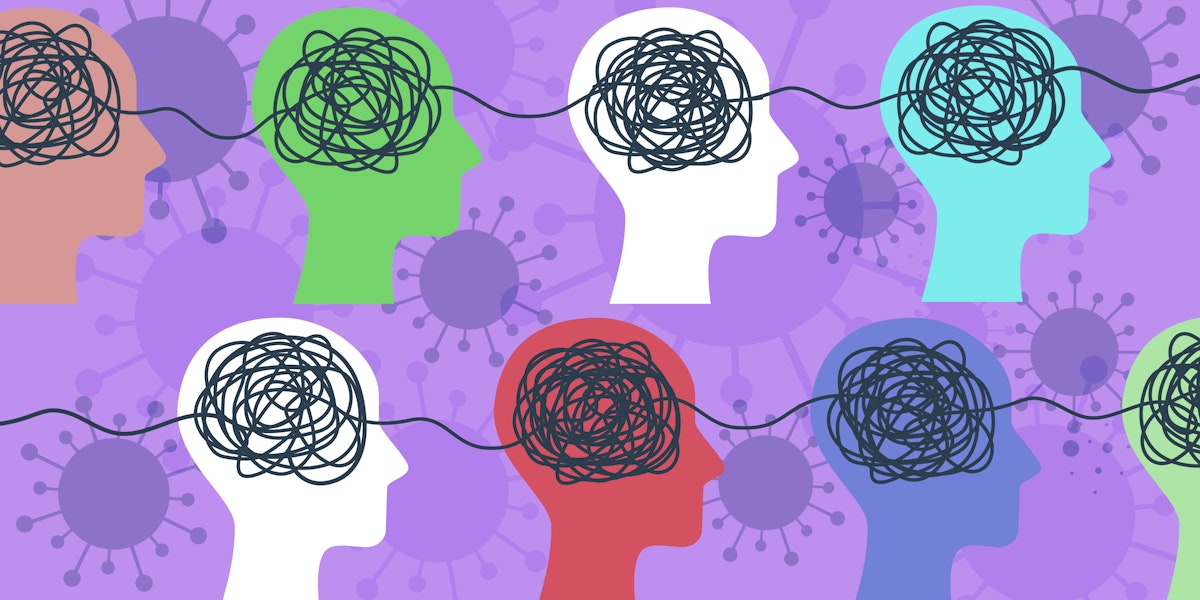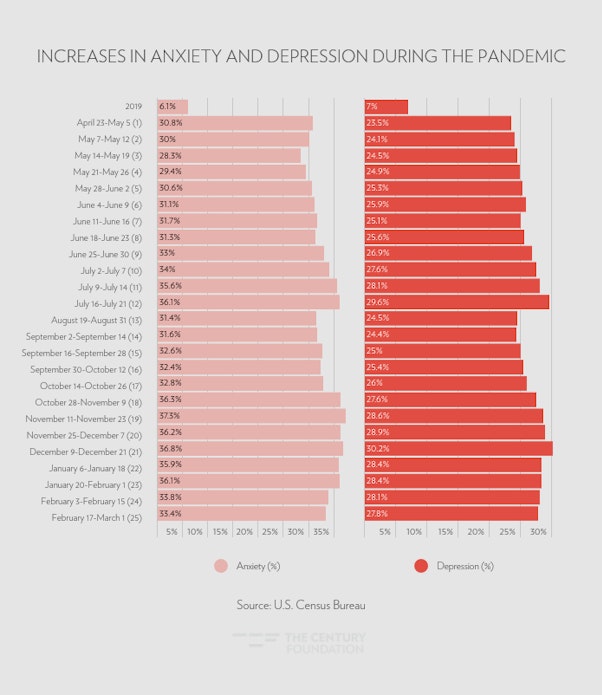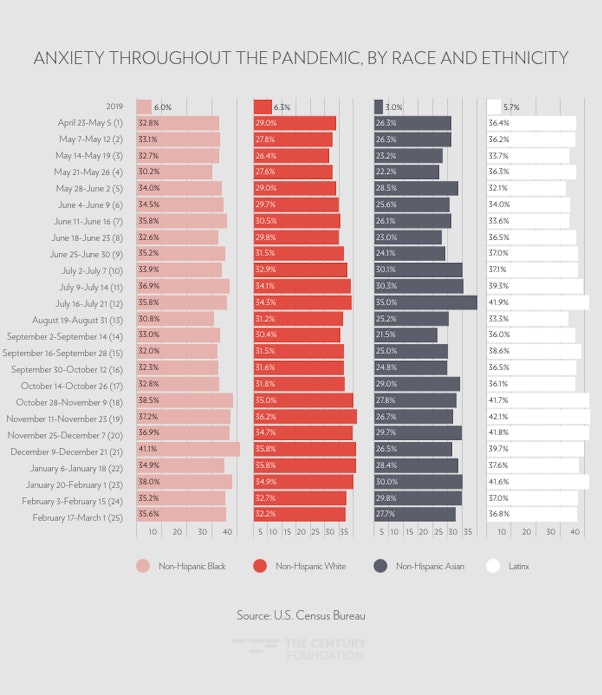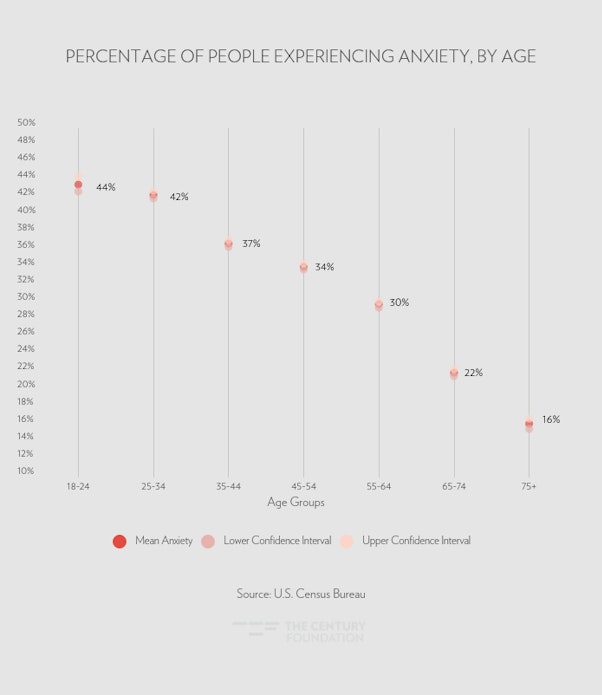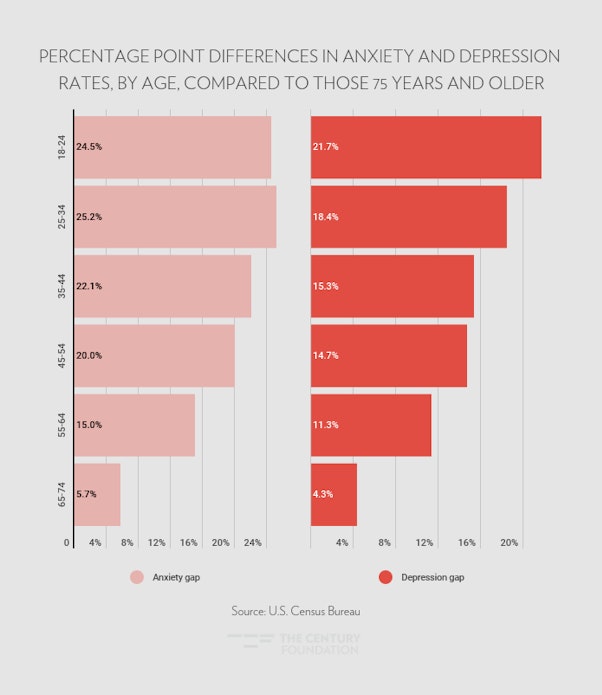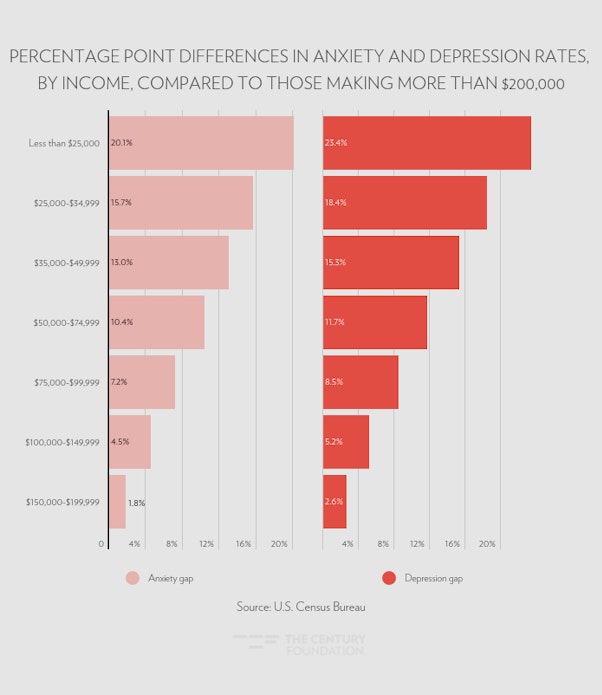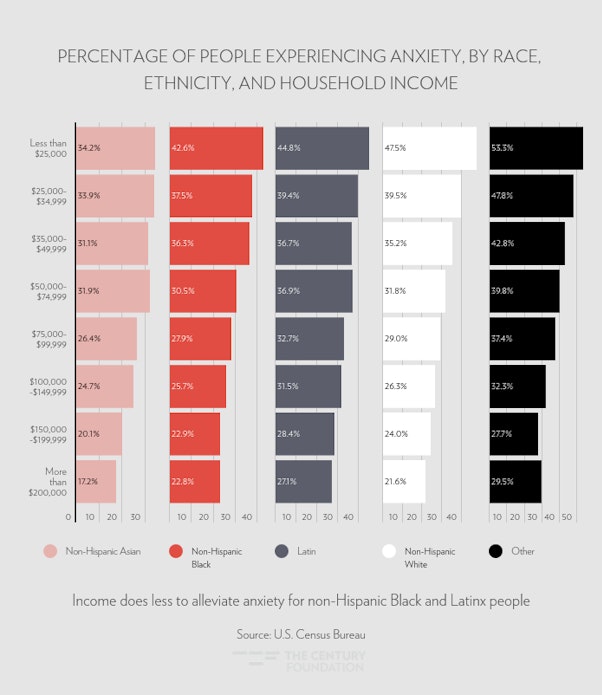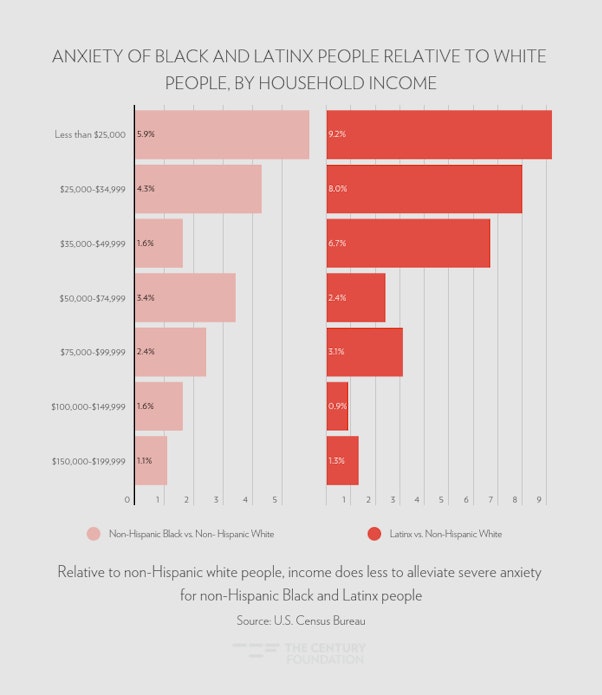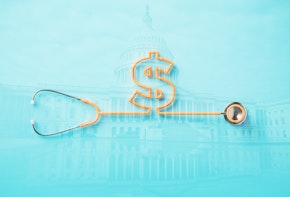The COVID-19 pandemic has had a tremendous impact on American society. The need to isolate to prevent spread of the disease led to the loss of over 22.0 million jobs, pushing the comprehensive measure of unemployment to over 20.0 percent, and the share of women working below 50.0 percent. And in terms of american’s physical health, the pandemic has been equally brutal, resulting in 30.2 million COVID-19 cases reported, and over one-half million deaths so far.1
The federal government over the past year has led a vigorous policy response to the damage that the pandemic has wrought on the economy and the physical health of the nation, authorizing over $3.1 trillion in relief and recovery support. However, there has not been enough done at the federal level to address what is frequently triggered by exposure to these unprecedented levels of social isolation, job loss, illness, and death: anxiety and depression.
The neglect of mental health concerns—particularly anxiety and depression—in the federal relief and recovery policy responses over the past year is a serious oversight. According to the U.S. Census Bureau’s first Household Pulse survey of 2021,2 for example, anxiety rates are now 35.9 percent, up from 6.1 percent3 before the pandemic.
This is not to say nothing has been done. In March of this year, Congress passed, and President Biden signed the $1.9 trillion American Rescue Plan Act of 2021 into law.4 The act makes historic investments that support better access to mental health care and other essential health provisions in response to the COVID-19 pandemic. New funding and programs outlined in the act primarily focus on prevention and treatment of mental health and substance use disorders and expanding access to affordable health insurance coverage.
A greater attention on mental health issues is long overdue. There is a well-developed literature on the increased incidence of depression, alcoholism, and drug overdose, particularly among young adults, even during the run-up to the pandemic.5 According to the Centers for Disease Control and Prevention (CDC), unintentional injuries (that is, drug overdoses), suicide, and liver disease (typically from alcoholism) are now the first, second, and sixth leading causes of death for people ages 15 to 44 years old.6 Princeton economists Anne Case and Angus Deaton label these three types of death as “deaths of despair” and link their increased incidence to a variety of economic forces that have made life harder for all types of workers and their families, especially among the white middle class.7 They also note that, due to systemic racism, Black Americans have faced even more challenging lives for a more extended period than white Americans, which can further worsen economic prospects as well as mental and physical health outcomes.
More than one year has passed since the pandemic’s onset, and the economy shows modest signs of recovery—which may translate into improved mental health for some Americans. As of February of this year, the unemployment rate had fallen from 14.8 percent in April 2020 to 6.2 percent. The economy recovered more than one-half of the 22 million lost jobs. The employment-population ratio has been trending up since April 2020.
But this modest economic rebound is not a cure-all. Many analysts and policymakers believe the labor market still has a long road to recovery. The more comprehensive U-6 unemployment rate still exceeds 10 percent. The share of the population that is employed has only recovered one-third of the decline that occurred. The unemployment rate of black Americans just fell below 10 percent, still well above the pre-pandemic level.
Against this backdrop of a slow economic recovery, it remains critical that the nation focus on initiatives that address mental health.
Against this backdrop of a slow economic recovery, it remains critical that the nation focus on initiatives that address mental health. The pandemic’s impact on mental health has spotlighted the challenges that Americans have faced for years, revealing the inadequacies of the nation’s health care system to provide much-needed mental health care. What was a serious concern before the pandemic has now transformed into a major public health crisis.
This report presents evidence to support the claim that current mental health challenges constitute a public health emergency. Using the U.S. Census’ Household Pulse Survey,8 the report shows that no single individual or group has a monopoly on anxiety and depression during the pandemic. The report’s primary findings are as follows:
- Moderate to severe anxiety peaked at 37.3 percent of the adult population during the pandemic, up from 6.9 percent in 2019
- Moderate to severe depression among adults jumped from 7.0 percent to 30.2 percent over the pandemic.
- The greatest concern is anxiety among young adults: during the pandemic, 43.5 percent reported moderate to severe anxiety.
- Income is a key indicator of mental health. Households with income less than $25,000 are 20.1 percentage points more likely to report moderate to severe anxiety than a household with income that is $200,000 or more.
If not fully addressed, the nation’s current mental health crisis will result in more “deaths of despair” going forward, even long after the pandemic has subsided.
The federal government must take additional administrative and legislative action to address the mental health needs of those disproportionately impacted by anxiety and depression since the start of the pandemic. As a start, the federal government should:
- invest in initiatives that support diversifying the mental health workforce,
- enforce mental health parity laws,
- address the digital divide,
- take into account key social determinants in policy making and implement public education campaigns, and
- address structural racism in health care.
The Evidence
In 2019, 6.1 percent9 and 7.0 percent10 experienced moderate to severe anxiety and depression, respectively. The U.S. Census Bureau offers insight into the pandemic’s effects through their Household Pulse Survey.11 Executed via text and email beginning in late April 2020, the survey offers over 1.5 million observations of respondents’ physical, mental, and economic well-being.
Figure 1 shows that by late April 2020, self-reported instances of moderate to severe anxiety and depression affected 30.8 percent and 23.5 percent of the population, respectively. Between late April 2020 and early March 2021, the rate of moderate to severe anxiety averaged 33.1 percent, while that for moderate to severe depression averaged 26.5 percent. Surprisingly, the rates are sporadic, jumping over 20 and 30 percent intermittently. There is a slight upward trend from April to July, which might be associated with the pandemic’s acceleration and lack of a significant relief and recovery effort. Another upward trend occurs between August 2020 and the end of the year, potentially associated with the colder weather and a lack of relief and recovery support.
Figure 1
People of color, women, and low- and middle-income households bore the pandemic’s brunt in their roles as essential workers with poorer health and access to health care. Figure 2 shows self-reported anxiety by race and ethnicity. Before the pandemic, non-Hispanic Asian people experienced the lowest levels of anxiety (3.0 percent), close to half the rates of other racial and ethnic groups. During the pandemic, all groups experienced significant increases in anxiety, particularly Latinx individuals, who consistently surpassed 40 percent of all adults exhibiting symptoms of moderate to severe anxiety over the second half of 2020, an increase of over 700 percent since 2019. Non-Hispanic Black people also surpassed the 40 percent mark.
Figure 2
In the decade preceding the pandemic, anxiety among young adults was already on the rise. Among people aged 18–25 years old, anxiety increased from 8.0 percent in 2008 to 14.7 percent in 2018.12
Over the pandemic, anxiety almost tripled for the 18–25-year-old group, averaging 43.5 percent between April 2020 and March 2021 (see Figure 3). If unaddressed, these crisis-level rates could translate into an increase in “deaths of despair,” which will have immediate, short-, and long-term consequences on economic growth.
FIGURE 3
How much of the previous racial and age patterns in self-reported anxiety and depression are influenced by educational attainment, income, marital status, and other factors? When we account for these factors, we find that the mental health disparities during the pandemic do not disappear. The sharp contrast and disparate impacts remain. For example, compared to their older counterparts, young adults experience more anxiety and depression—even when accounting for gender, income, race/ethnicity, marital status, and time. Specifically, individuals under 35 years of age experience moderate to severe anxiety rates that are close to 25 percentage-points higher than older individuals (see Figure 4). Consequences of poor mental health include lack of productivity in school and the workplace, both today and, more importantly, the future. Young adults disadvantaged by poor mental health will play a losing game of “catch-up” with their healthier peers over their lifetime. The COVID-induced mental health crisis of today is begetting stalled economic growth and inequality in the future.
FIGURE 4
Figure 5 illustrates the relationship between income and reported mental health status during the pandemic. Compared to those in households with at least $200,000 in annual income, lower-income individuals experience more moderate to severe anxiety and depression. For those with income less than $25,000 per year, anxiety is 20 percentage-points higher relative to those from households with income of at least $200,000. The depression gap is slightly higher. Does low income cause poor mental health? Or does poor mental health result in low income? Likely a little of both, but lower-income households are disparately affected by mental health, likely stalling their success in the labor market and disadvantaging their lifetime economic progress and advancement. Lower-income also generates challenges in accessing technology to utilize mental health resources via telemedicine.
FIGURE 5
Digging into the income differentials by race reveals a graver story. Figure 6 shows that, on average, low-income households within each racial/ethnic group experience greater anxiety than their higher-income counterparts. Except for non-Hispanic Asian people, over 40 percent of individuals from households earning less than $25,000 per year, suffer from moderate to severe anxiety (see Figure 6). As income rises, anxiety falls, but by different magnitudes. Non-Hispanic white people saw their anxiety share fall by more than half, declining to 22 percent. Comparatively, minorities see their anxiety share falling by less than half, with the Latinx rate remaining close to 30 percent.
FIGURE 6
Controlling for the influence of gender, marital status, age, and time, the impact of income largely remains. Non-Hispanic Black and Latinx people experience more anxiety at all levels of income, and the gap persists even at the highest levels. Compared to households earning more than $200,000 per year, non-Hispanic Black and Latinx people experience more anxiety at all income levels (see Figure 7).
FIGURE 7
Recommendations
As the nation moves into the spring and early summer months, the economic recovery is pivotal. The vaccine is becoming widely available. Temperatures are warming, meaning people can socialize outdoors, which can combat isolation without spiking infection rates. Several states—prematurely—have even removed their mask requirements. The number of initial Unemployment Insurance claims has started to trend downward but still exceeds one-half million per week.
These signs that the pandemic may be waning are certainly welcome, and yet an increased attention placed on mental health issues is still long overdue. Research has shown in great detail that a mental health crisis existed well before the pandemic.13 If left unchecked, anxiety and depression will lead to more “deaths of despair” during and long after the pandemic.
The components of the American Rescue Plan Act of 202114 that address mental health are a long-overdue down payment for those who have suffered from mental health challenges. The act makes historic investments that support better access to mental health care and other essential health provisions in response to the COVID-19 pandemic. New funding and programs outlined in the act primarily focus on prevention and treatment of mental health and substance use disorders and expanding access to affordable health insurance coverage.
Notable provisions in the American Rescue Plan Act that help address the nation’s mental health crisis include:
- premium assistance under COBRA to support laid-off workers with much-needed health coverage;
- temporary expansion of ACA subsidies for two years to support affordable coverage options during the pandemic recession;
- designation of an enhanced federal medical assistance percentage (or FMAP) to incentivize Medicaid expansion in states that have yet to do so, primarily concentrated in the South;
- increased access to telehealth and mobile crisis services; and
- increased availability of community-level behavioral health clinics and services.
The Biden–Harris administration recently announced that it would extend open enrollment within the ACA health insurance marketplaces through August 15, 2021, allowing more people to take advantage of new coverage and affordability provisions included in the American Rescue Plan Act.15 Mental health and substance use disorder services are one class of ten essential health benefits that must be covered under marketplace plans as codified by the ACA.16
Additional actions are needed to better address the mental health needs of those disproportionately impacted by anxiety and depression since the start of the pandemic. As a start, the Biden-Harris administration and Congress should:
- invest in initiatives that support diversifying the mental health workforce and address provider shortages in high-need areas, including neighborhoods predominantly inhabited by people of color and within rural communities;
- enforce mental health parity laws, such as the Mental Health Parity and Addiction Equity Act,17 which prohibit certain health plans and health insurers from imposing limits on mental health benefits that are less favorable than the limits imposed on medical benefits;
- address the digital divide by increasing access to broadband internet and relevant devices so that people in high-need communities can access new expansions in telehealth services;
- take into account key social determinants in policymaking, including economic security, and how they impact the mental health and wellbeing of low-income people and people of color;
- implement public education campaigns to help dismantle the stigma associated with mental health challenges brought on by the COVID-19 pandemic, and target messaging to meet the unique needs of diverse populations; and
- address structural racism in health care and other social systems by ensuring adequate training of providers to recognize and eliminate bias and discrimination in care.
Notes
- The job loss figures come from the U.S. Bureau of Labor Statistics, www.bls.gov. The more comprehensive estimate of the jobless rate is the U-6 unemployment rate. Along with those responding that they are searching for a job, it includes individuals who are working part-time but they want to work full-time and those who have left the labor force, but if offered a job they would accept it. The COVID-19 estimates come from the New York Times’ interactive graphic, available at https://www.nytimes.com/interactive/2020/us/coronavirus-us-cases.html.
- Values in Figure 1.1 are calculated weighted averages by the authors using Weeks 1–25 of the U.S. Census Household Pulse Survey. To find the data used to generate the results, please go to https://www.census.gov/programs-surveys/household-pulse-survey/data.html.
- Maria A. Villarroel and Emily P. Terlizzi, “Symptoms of Depression Among Adults: United States, 2019,” NCHS Data Brief 379, U.S. Department of Health and Human Services, September 2020, https://www.cdc.gov/nchs/products/databriefs/db379.htm.
- American Rescue Plan Act of 2021, H.R.1319, 117th Congress (2021–22), https://www.congress.gov/bill/117th-congress/house-bill/1319/text.
- See for example Pinka Chatterji, Dhaval Dave, Robert Kaestner, and Sara Markowitz, “Alcohol Abuse and Suicide Attempts Among Youth,” Economics and Human Biology 2, no. 2 (2004): 159–80; A. E. Cuellar, S. Markowitz, and A. Libby, “The Effects of Mental Health and Substance Abuse Treatment on Juvenile Crime,” Journal of Mental Health Policy and Economics 7, no. 2 (June 2004): 59–68; and Alan B. Krueger, “Where have all the workers gone? An inquiry into the decline of the U.S. labor force participation rate,” Brookings Institution, September 7, 2017, https://www.brookings.edu/bpea-articles/where-have-all-the-workers-gone-an-inquiry-into-the-decline-of-the-u-s-labor-force-participation-rate/.
- “Health, United States, 2019—Data Finder,” Centers for Disease Control and Prevention, https://www.cdc.gov/nchs/hus/contents2019.htm#Table-007.
- Anne Case and Angus Deaton, Deaths of Despair and the Future of Capitalism (Princeton: Princeton University Press, 2021).
- “Household Pulse Survey,” U.S. Census Bureau, https://www.census.gov/programs-surveys/household-pulse-survey.html.
- Emily P. Terlizzi and Maria A. Villarroel, “Symptoms of Generalized Anxiety Disorder Among Adults: United States, 2019,” NCHS Data Brief 378, U.S. Department of Health and Human Services, September 2020, https://www.cdc.gov/nchs/products/databriefs/db378.htm.
- Maria A. Villarroel and Emily P. Terlizzi, “Symptoms of Depression Among Adults: United States, 2019,” NCHS Data Brief 379, U.S. Department of Health and Human Services, September 2020, https://www.cdc.gov/nchs/products/databriefs/db379.htm.
- “Household Pulse Survey,” U.S. Census Bureau, https://www.census.gov/programs-surveys/household-pulse-survey.html.
- Renee D. Goodwin, Andrea H. Weinberger, June H. Kim, Melody Wu, and Sandro Galea, “Trends in anxiety among adults in the United States, 2008–2018: Rapid increases among young adults,” Journal of Psychiatric Research 130 (November 2020): 441–46, https://www.sciencedirect.com/science/article/abs/pii/S0022395620309250?via%3Dihub.
- Anne Case and Angus Deaton, Deaths of Despair and the Future of Capitalism (Princeton: Princeton University Press, 2021).
- American Rescue Plan Act of 2021, H.R.1319, 117th Congress (2021–22), https://www.congress.gov/bill/117th-congress/house-bill/1319/text.
- Chelsea Cirruzzo, “Biden Extends Health Insurance Marketplace through Summer,” U.S. News and World Report, March 23, 2021, https://www.usnews.com/news/health-news/articles/2021-03-23/biden-extends-health-insurance-marketplace-through-summer.
- “What Marketplace health insurance plans cover,” Healthcare.gov, https://www.healthcare.gov/coverage/what-marketplace-plans-cover/.
- See “The Mental Health Parity and Addiction Equity Act (MHPAEA),” Centers for Medicaid and Medicare Services, https://www.cms.gov/CCIIO/Programs-and-Initiatives/Other-Insurance-Protections/mhpaea_factsheet.
